It’s been an exhausting few years for HR leaders. Between a global pandemic, working from home, quiet quitting, hybrid work, economic uncertainty, gen AI, return to the office then back to hybrid, it’s no wonder many workers lack motivation. As leaders and organizations strive to enhance employee engagement and productivity, it’s essential we move beyond conventional theories and explore new dimensions of motivation.
In the quest to motivate and engage employees, the elements of purpose, autonomy, and mastery stand out as key drivers. These are not new concepts; they are rooted in extensive research and have been eloquently summarized by Daniel Pink in his book “Drive”. Pink’s “Motivation 3.0” theory posits that intrinsic motivation is fueled by three elements: purpose, autonomy, and mastery. But let’s take them a step further.
Reimagining purpose
Purpose has always been a critical driver of motivation, but it’s time to reframe how we think about it. Employees today seek more than just a connection to the company’s mission; they crave a personal alignment with their work. This means fostering an environment where individuals can see how their unique contributions impact the broader goals.
Purpose isn’t just about the company’s vision but also about individual aspirations. Encouraging employees to articulate their personal goals and showing how these align with organizational objectives can create a deeper sense of purpose. For example, a study by PwC found that 83% of employees believe it is important for their values to align with the company’s mission. An engineer passionate about sustainable development can be motivated by projects that contribute to the company’s green initiatives, creating a win-win scenario.
Tapping into the motivational power of purpose can be as obvious as focussing on the connection between the organization’s output and the good in the world. An energy company drives for greater output because its product helps developing countries thrive and in the process enhances lives. Similarly, leaders can support employee connections between the organization’s values and individual values to motivate people to outpace the competition. Knowing that the communities and markets they serve are better served by an organization that employs responsible, values-driven ways over the competition can be an incentive to perform.
Expanding autonomy: beyond the managerial paradigm
While autonomy is a well-established motivator, its role is evolving. Traditional management often viewed autonomy as a luxury, but in today’s knowledge-based economy and work-from-anywhere culture, it’s a necessity. Autonomy should not only be about the freedom to choose how tasks are completed but also about empowering employees to identify and pursue innovative projects.
Structured autonomy involves setting clear goals and boundaries while giving employees the freedom to explore and innovate within those parameters. A study from Harvard Business Review showed that companies allowing for greater autonomy experienced a 20% increase in employee performance. Providing dedicated time for personal projects or encouraging cross-functional team collaborations can lead to breakthroughs that wouldn’t occur in a strictly controlled environment.
Another way to unleash the motivating potential of autonomy is investing in the capability of people. The more capable they become the less oversight is required and the more they own the outcomes of their efforts. Working with employees to invest in knowledge, skills, and abilities that can enable them to be liberated in the work they do has immense potential for performance and satisfaction.
Mastery in the age of continuous learning
Mastery remains a cornerstone of motivation, but the approach to achieving it needs to evolve. Instead of focusing solely on addressing skill gaps, organizations should emphasize enhancing existing strengths. This shift from a deficit-based approach to a strengths-based approach can lead to higher engagement and better performance.
Personalized learning paths are crucial. According to LinkedIn’s Workplace Learning Report, 94% of employees said they would stay at a company longer if it invested in their career development. By leveraging platforms like Growthspace, companies can offer tailored development programs that cater to individual strengths and career aspirations. Encouraging employees to pursue mastery in areas they are passionate about can result in a more motivated and skilled workforce.
The role of leadership in fostering a motivational culture
Leadership plays a pivotal role in creating a motivational culture. It’s not just about setting the vision but also about embodying the values of purpose, autonomy, and mastery. Leaders should be transparent about organizational goals and actively involve employees in decision-making processes. This builds trust and demonstrates a commitment to employee development.
Feedback, development, communication, and recognition are essential. Regular, constructive feedback helps employees understand their progress and areas for improvement. Open dialogue and the building of a trusted relationship help ensure employees feel seen and heard. Recognition of achievements, no matter how small, can significantly boost morale and motivation. A Gallup survey found that employees who receive regular recognition are more productive, engaged, and more likely to stay with their company.
Balancing process and flexibility
Balancing process and flexibility is key. While having a structured process is essential for clarity and consistency, it shouldn’t stifle creativity and innovation. Leaders need to create an environment where processes guide and support employees, but flexibility enables experimentation and personal growth.
Adopting a flexible project management approach where employees can propose new ideas and work on them within a structured framework can lead to increased innovation and job satisfaction. A study from the American Psychological Association found that employees who feel they have control over their work are more likely to be satisfied and less stressed.
Conclusion
Integrating purpose, autonomy, and mastery into the workplace goes beyond theoretical frameworks. It requires a deep understanding of individual and organizational dynamics and a commitment to continuous improvement. By reimagining purpose, expanding autonomy, and emphasizing strengths-based mastery, organizations can create a more engaged and motivated workforce.
As we navigate the complexities of modern work, it’s essential to keep evolving our strategies to meet the changing needs of employees. Purpose, autonomy, and mastery are not just concepts but practical tools that, when effectively implemented, can drive sustained engagement and performance.
This article is part of the Precision Matters series. In the series, HR and L&D leaders share their expert strategies for utilizing Learning & Development tools to craft precise, impactful business outcomes and foster organizational growth.
Ready to turn insights into impact?


















